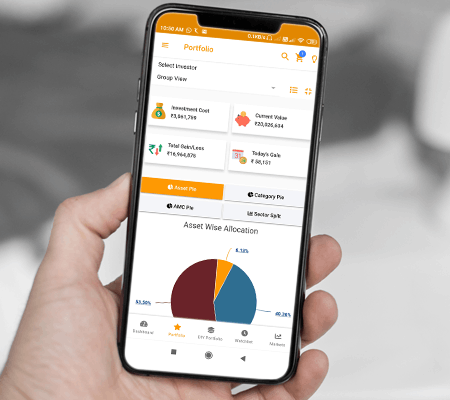Heading will come here
View Now- ICICI Prudential Advisor Series - Dynamic Accrual Plan 31.85 0.00(0.00%)
|
10,195.15 10.2600 (-3.3%) 16-03-2018 12:00 |
Prev Close 10,360.15 | Open 10,345.15 | High 10,346.30 | Low 10,180.25 | Details |
| NSE: Asian Paints | BSE: 500820 | Sector: Chemicals |
|
NSE Mar 16 2018, 4:01 1,160.80 23.90(+3.90%) |
BSE Mar 16 2018, 4:01 2,260.90 23.90(+3.90%) |
View Details |
Invest Guide November 2024
CEO's Desk
Dear Investors,
As we navigate the complexities of 2024, the investment landscape in India presents both challenges and unprecedented opportunities. Our economy is showing remarkable resilience, supported by projected GDP growth of 6.5% this year, driven by strong domestic demand and robust manufacturing activities.
S&P BSE Sensex and CNX Nifty rose by about 6.66% and 7.5% respectively during the quarter. During the quarter Nifty Midcap 100 index outperformed the Nifty 50, with a gain of 7.92%, however, Nifty Small cap 100 index underperformed both Nifty 50 and Nifty Small cap 100, with a gain of 4.71% respectively during the quarter. Among sectoral indices Nifty Pharma and Nifty IT were top performers while Nifty Financial Services and Nifty Realty were worst performers during the quarter.
India's manufacturing PMI compiled by S&P Global, stood at 56.5 in September, down from 57.5 in August and 58.1 in July. The manufacturing activity slowed to an eight-month low in September as rates of expansion in factory production and sales receded, and international orders rose at the slowest pace in a year and a half. However, the index has remained above its long-term average and the 50-point mark - which separates contraction from expansion - for nearly three years. The HSBC India Services PMI fell to 58.9 in September 2024, down from 60.9 in the previous month. This marked the 38th consecutive month of growth in services activity but at the slowest pace since November 2023, amid softer expansions in both new orders and output.
India's Consumer Price Index (CPI)-based retail inflation rose marginally in August to 3.65 per cent from 3.6 per cent in July, yet remained below the Reserve Bank of India (RBI)'s medium-term target of 4 per cent for the second time in nearly five years, mainly because of a high base during the same period a year ago. The food price inflation for August was marginally higher at 5.66% compared to 5.42% in July.
India's economy grew at 6.7% in the April-June quarter of FY25 over the growth rate of 8.2% in Q1 of FY 2023-24. This figure reflects a deceleration from the 7.8% growth seen in the previous quarter of FY24. The slowdown in growth was due to sluggish performance of the agriculture and services sectors.
On September 18, the US Federal Reserve started its rate-cutting cycle. It reduced the Fed Funds rate by 50 basis points, bringing it down from 5.25-5.50% to 4.75-5.00%. Fed Chair Jerome Powell noted that the labor market has cooled, no longer serving as a major inflationary factor. Domestically, the Indian bond yields has moderated across all the tenors due to a decline in crude oil prices and global bond yields. The 10-year India G-Sec yield ended the quarter at 6.75%, down 26 basis points.
In respect of currencies, Indian Rupee depreciated by ~0.49% during the quarter to INR 83.80/$ as compared to 83.39/$ at the end of previous quarter. On the commodity side, crude oil prices moderated by ~10.5% during the quarter, now at ~US$73.7/bbl level.
As we enter into third quarter of FY25, in terms of the valuations of the markets, Nifty is currently trading at approximately 21.6x 1-year forward earnings. GDP growth and earnings have moderated recently. Although valuations are not cheap but factors such as US Fed rate cut, fall in the US Dollar and weakening of the Chinese market can still continue to drive FII inflows into Indian equities. The smooth transition of power and formation of the new government post-elections have already created a favourable environment, and the US Fed rate cut has now accelerated FPI investments. However, any escalation in the geo-political conflicts and the US election outcome pose the risks for the markets.
Overall, we are a bit cautious about markets in the near term due to rich valuations and geo-political concerns but remain constructive on Indian equity markets in the medium term. Strong public capex over last 4 years has created investment side momentum and public capex is expected to translate into private capex cycle, given strong corporate balance sheets. Indian banks continue to have strong balance sheets to support the possible capex and real estate cycle. Government's focus on manufacturing is likely to drive medium term earnings growth in the economy, thus benefiting equities.
We feel that strong flows in the equity markets - both domestic and FII are likely to cushion any major fall in the markets. For investors looking to invest in equities, we suggest not to keep waiting till a big correction to start investments. However, in our view, equity investors should avoid lumpsum investments and invest in a phased manner using SIPs or STPs, allowing gradual market entry and reducing risk. Whenever a market correction occurs, investors can capitalize on lower valuations by increasing their equity exposure. On fixed income side, we remain positive on fixed income markets and expect a downtick in the yields to continue.
By staying informed and adaptable, we can collectively navigate the challenges and harness the potential of this vibrant market. Your partnership is invaluable as we strive for sustainable growth and innovation. Together, let's seize the moment and create lasting value for all. Thank you for your continued support as we navigate this dynamic environment together!


































